The wonderfully crafted mini-series Emma brings together a masterful combination of costumes, set decoration, production and cinematography. Featuring Romola Garai in the leading role, it follows a story of a radiant upper-class girl that finds a passion in match-making. The soft richness of costumes is combined with deliberately lingering camera work, captivating the eye with exquisite palettes of colors and textures.

This scene is softly dominated by two colors, brownish orange and desatured green. The scarf wrapped around Emma’s elbows is replicated in the paisley pattern of her dress, the simple necklace, the brick building in the background and the hair of the supporting actress. Intricate floral pattern of the dress plays nicely with the verdant hedge.

This is perhaps the most striking color pair – deep maroon and metallic teal. In this scene, both colors seem to be a natural extension of the surrounding environment (the brick wall and foliage). The midnight blue of the male character’s jacket completes the palette.

And here is the same costume in an indoors setting. Yellow floral patterns of the wallpaper and golden olive of the wooden frames are a striking setting, with metallic teal of her sash mirrored in a small vase in the background.
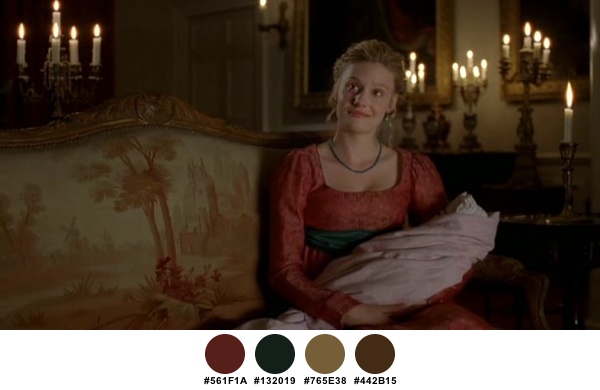
Candlelight immerses the scene, bringing deeper tones and highlighting the slightly reflective fabric. The upholstery is illuminated in diffuse light, with no reflections or highlights.

The evening meal is dominated by a gamut of golden brown masterfully offset by the seaweed green of the dress. Burgundy red is seen in the wine glass, the hair ribbon and blurry elements in the background.
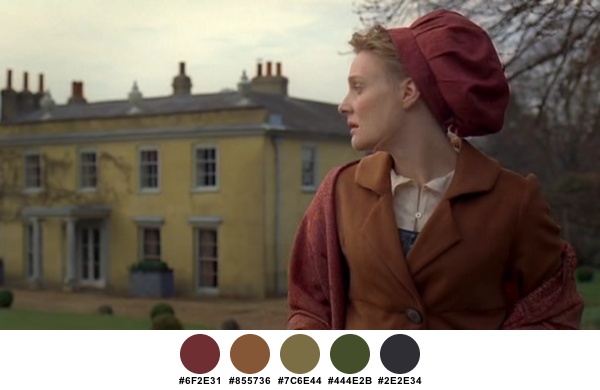
Here the camera explores the warm part of the rainbow, transitioning from peach reds and oranges to the sand yellow of the building and glimpses of green grass, and a tinge of steel blue that connects Emma’s shirt and a flower container next to the building.

Continuing to favor the deep red hues, Emma’s costume ventures into dark orange and brown. A much simpler, but not less elegant combination of light gray and olive green is seen on Louise Dylan’s character.
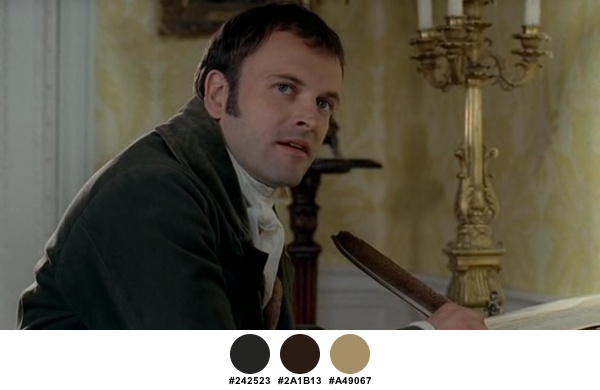
Staying within the confines of slate gray, Jonny Lee Miller’s shirt borrows the brown from his hair, the background set piece and the quill pen.

An attractive complement to her golden tresses, the soft yellow fabric of her dress is strewn with an irregular floral patterns of desaturated greens and purples. Note how the indoor light casts deep golden shadows on her skin, seemingly borrowing from the wallpaper and the hanging picture.
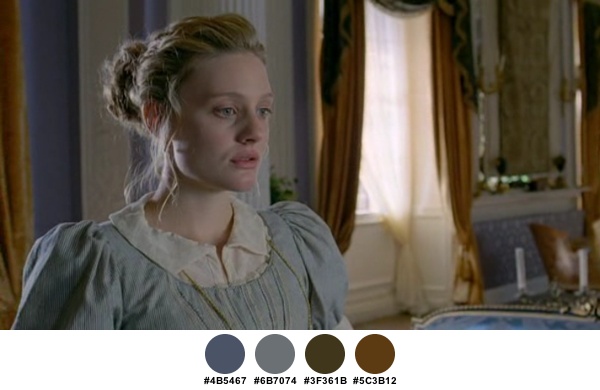
A much cooler palette of predominantly lilac gray serves as a perfect backdrop to one of the more dramatic scenes.

Scenes mainly focusing on the male characters switch to subdued palettes that are mainly based on earthen greens, browns and beiges.

A setting normally dominated by yellow seems to be overpowered by the brown tones of his shirt and hair. Also note a nice color connection between his jacket and the small table vase.

This is just one example of magnificent scarves adorning Michael Gambon’s neck. An even deeper shade of maroon highlights his constant obsession with health in an otherwise serene setting of soft grays and sand yellows.
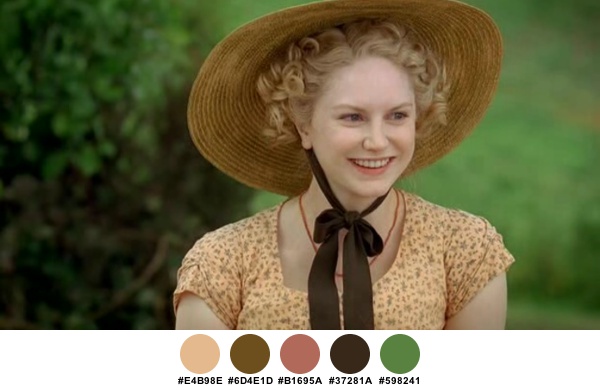
A festive outdoor combination of pastel yellow, golden brown and slate brown highlight the petulant youthfulness of Harriet Smith.
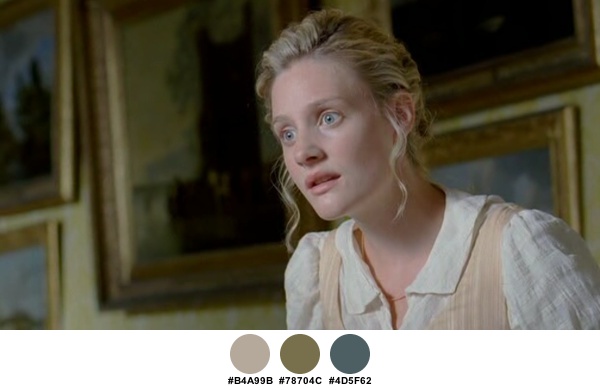
One of my favorite settings – note how the wide swaths of desaturated blue nature scenery in the pictures bring out a tinge of blue in Romola’s eyes.

Seemingly borrowing from the skin and lip tone, the soft coral peach of her dress highlights Emma’s connection to her house.
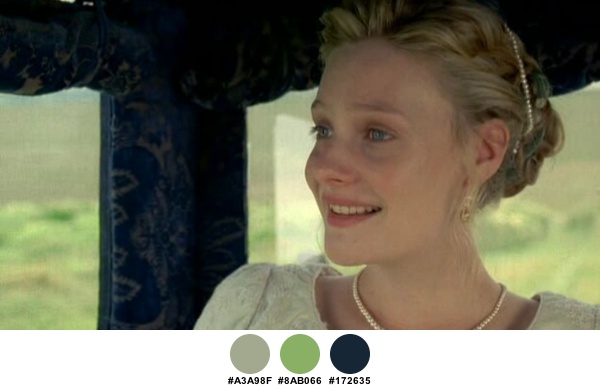
Peace at last. Deep sea blue of the carriage has just a hint of green that combines with the hair beads in this final scene.
Production design: Stevie Herbert
Costume design: Rosalind Ebbutt
Art direction: Pilar Foy
Set decoration: Louis Turner
Cinematography: Adam Suschitzky
It seems like every time I watch “Tron: Legacy”, I find yet another visual layer to explore and enjoy. After talking with GMUNK about the visual effects, it’s time to take a deep dive into the beautiful world of Tron make-up. With X-Men, Fantastic 4, Watchmen, Sucker Punch, Tron: Legacy and the upcoming Underworld (just to name a few), Rosalina Da Silva has one of the most impressive resumes in the world of big budget sci-fi movies in the last decade. I’m very honored to host a conversation with Rosalina, starting from her work on Tron and later touching on the general craft of big screen make-up wizardry.
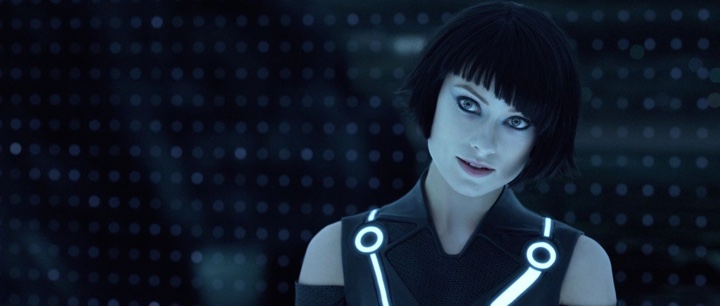
Kirill: Can you walk us through the process of interacting with different art departments and defining the visual look of the movie and the characters?
Rosalina: It depends. Sometimes I’m given a script, and other times – for example for Sucker Punch – I had access to a DVD that showed the concept and vision of the director. You start working on the script or these materials, and in general you do a lot of research. I research photographers, for example David LaChapelle and others that are very creative in the looks that they achieve. I go through different types of magazines and movies, trying to create something. I research the latest make-up looks of the European runways, I watch what the make-up artists are doing on those shows – it’s always a great inspiration. You cannot bring those shows to the screen, but you certainly be inspired by them.
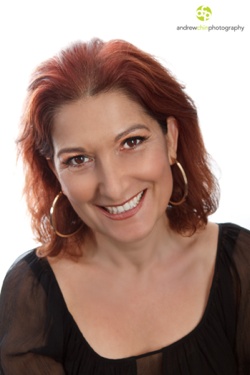 Kirill: Do you pitch a few different looks?
Kirill: Do you pitch a few different looks?
Rosalina: Usually i’ll build a book for the movie i’m working on with images and tearsheets from magazines, and i’ll show my ideas to the director, and then he’ll let me know if i’m on the right track. We start there and then narrow in given the director’s feedback and the look that he wants. Then we start testing and testing and testing and trying to achieve the look that they want. We’ll do the make-up tests to see how it looks on the screen; when you put it on the screen it’s different from how it looks on paper.
Kirill: At which point do you start working with hair stylist and costume designer?
Rosalina: Pretty much straight away. Makeup and hair stylist / designers usually get hired at the same time. Often the costume department starts earlier, so when we go in, we look through their sketches and the color scheme that they’re going for; that’s another inspirational point to look at everything they’ve done so far. And the same is true production designers and everybody else – Often they’ve been in production for months and had a lot of meetings. You look at the sketches and their vision for the movie, and that’s your main source of inspiration for the movie – to complement the work that they’re doing.
Kirill: Do you tweak your work based on the actual set lighting or preliminary post-production treatment?
Rosalina: Usually we tweak the looks once we get the actors. Sometimes the look does not complement the actor, so when they come in, we try to put our ideas on the skin and facial structure and make sure it all works together. They also have an opinion which we listen to, and then we do the make-up tests on screen.
Kirill: And you’re on the set every single day?
Rosalina: Exactly. We come in in the morning before everybody else, we get the actors ready for the day and then we go on set. Sometimes there are changes throughout the day if they shoot different parts of the movie, so you have to change the look, adding or taking off what is necessary.
Kirill: As I was looking for some background on your work, I happened upon a site that details dozens of products that go into the final look for one character. How much do you need every day to create that look?
Rosalina: Obviously the production wants to make it as fast as possible. The actors need to have some time off, and there’s only so many hours during the day that they can shoot, and of course they’d rather have them on set rather than sitting in the make-up chair. Some looks can be done in an hour or an hour and a half, including make-up, hair and wardrobe. It depends on how intricate the look is and how much works has to be done.
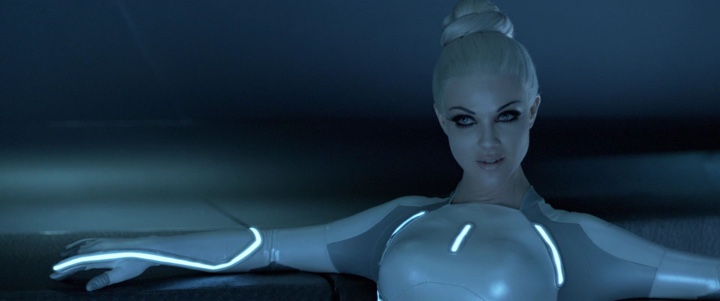
Kirill: Most of the story happens in a computer world, with very stylish black and white environment and precise lines. Was it an interesting challenge to create a look for what are essentially computer program characters?
Rosalina: Absolutely. Honestly, when I first read the script I didn’t know what to do. It was challenging for me at the beginning. But as I said, the costumes had already been designed, so I started looking at the sketches. Our director [Joseph Kosinski] has background in architecture and he loves simple straight lines. I knew that whatever we had to do for him had to be very clean and streamlined. And since it was all very new to me, with computer world and a 3D production, I had to keep it very simple to make it stunning, sexy, beautiful and appealing to the eye. So me and my team started to work, and we decided to keep it monochromatic – the colors of the grid – and to develop the black and white make-up with straight lines.
Kirill: It resonates nicely with the binary nature of the computer world, zeroes and ones, black and white.
Rosalina: It was that. You look inside the computer and you see the structural grid, and you take all the little shapes from there and create those shapes on different faces.
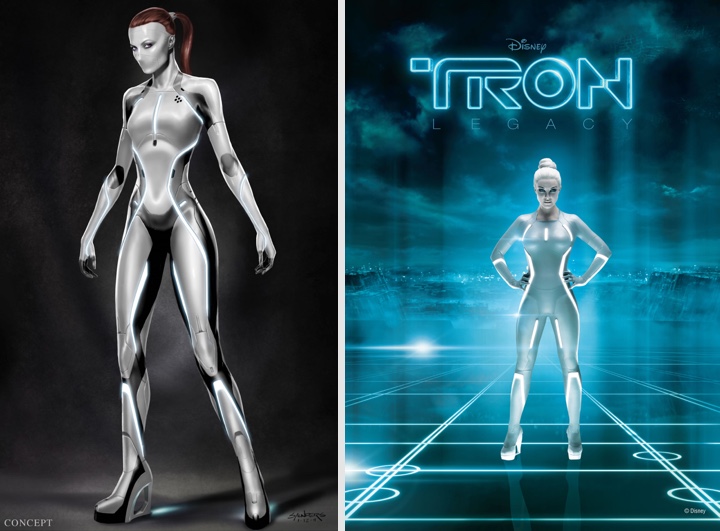
Kirill: When you start with the surrounding set design and costume, how much freedom do you have in designing the looks of the specific characters?
Rosalina: I had all the freedom that I wanted, being inspired by this. The challenge is to work with the costumes, to make sure that this person looks amazing with the costume, the make-up and the hair.
Kirill: Even when you remove all the skin and lip color?
Rosalina: Exactly. The original design concept of the Sirens had a mask over their mouth – but that was not looking quite right. Things evolved and changed, and I decided to go for a nude lip, to create a naked look on a shapeless face, removing any redness on the lips, making it blend and bringing a lot of attention to the eyes. I wanted them to be dolls, since they were made by the other characters – flawless dolls with big eyes, just stunning women.

Kirill: The club scene in the “End of Line” has a lot of supporting cast, and every single one of them has his or her own style. How much effort do you spend on the supporting characters and how important is it to have a complete look for everybody?
Rosalina: Very important since they are part of the scene since they must belong there and support the main cast. On the day we were doing that scene we had 21 make-up artists to get everybody ready. Everybody was fitted for hair, make-up and wardrobe to suit the whole look, and every single make-up was designed prior to that day. We put all the looks in a book, showing it to the director every day or so, and he would choose the looks that appealed to him.
Kirill: Do you work with stand-in replacements for a big scene like this?
Rosalina: We used the actual background actors. They would come in for fitting, and he or she would be designed on. They came for 3-4 days before starting the shooting, and we designed every single face.
Kirill: A scene like this is not shot in one day?
Rosalina: It takes a few days to shoot such a scene, maybe a week. We had quite a few scenes where the challenge is to make sure that different actors in different scenes do not have the same look. We had different types of programs in the script and we didn’t even have common names for them like people do. The whole script was computer language, and it was quite a bit of a challenge for me [laughs].
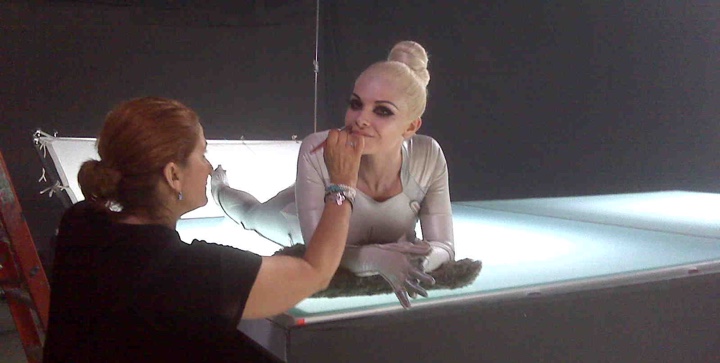
Kirill: For these multi-day scenes, how do you make sure that the look is consistent for the final cut?
Rosalina: We make charts to help with the continuity of the of the make-up…on a day to day basis, taking close-up photos and writing down everything we do – to have full references. We do continuity photos for everyone, not only for the next day, but also for reshoots six months later. We reshot some of the scenes in the lightcycle game, and you can barely see it.
Kirill: That’s the best outcome where the viewers can’t tell. What’s the reason for the reshoots?
Rosalina: Sometimes during the editing they want to make a scene more complete and have extra footage. Sometimes you want to develop or enhance a character a little bit more. This comes up at the end of the shoot when they start editing and putting the movie together. It hardly ever happens that there are no reshoots.
Kirill: I saw a few faces with deep scars running across. Was it part make-up, part computer-generated?
Rosalina: That was Bill Terezakis who designed the scars and the half-face man. The scar was fully make-up, and the half-face man was computer graphics together with make-up.
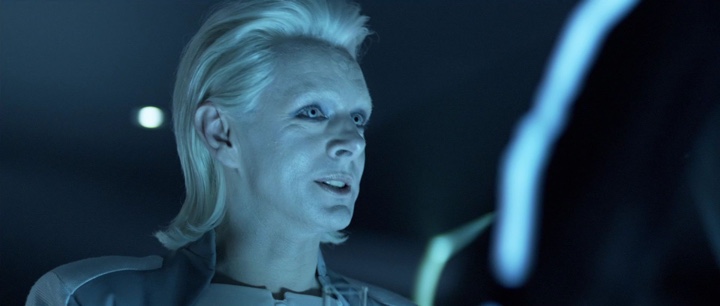
Kirill: Is it more fun to work on villain characters, like Castor and Jarvis?
Rosalina: Both characters were very challenging. We shaved James Frain’s head and bleached his eyebrows for his Jarvis character; most people don’t know who he is. And Michael Sheen underwent a total transformation as well, with the wig and full beauty make-up. He was wonderful to collaborate with, giving us ideas and taking inspiration from Ziggy Stardust. The Sirens were also very challenging and fun make-up to do. I kept Garrett very simple; as a human it was very important that he didn’t look like anybody else on the grid. I did a little bit of corrective make-up to just show off his good looks. Quorra could not look like a Siren, she had to be more human. She was undercover, hidden away, so she had to look different, but not very noticeably different. Olivia Wilde is a stunningly beautiful woman, and we had a lot of choice with her character.
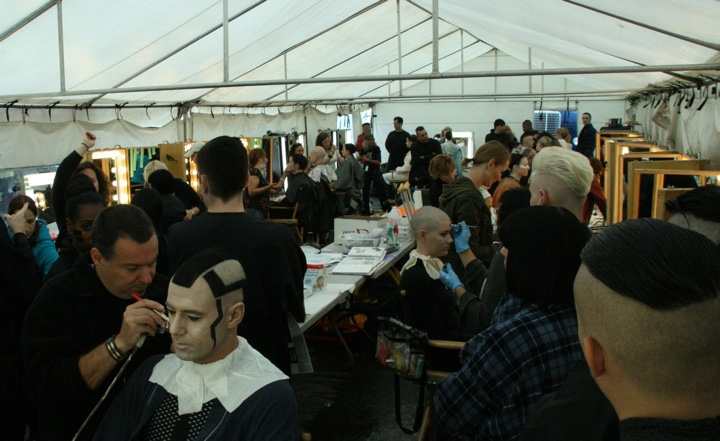
Kirill: How did it feel to see the complete look on the set?
Rosalina: We went to the set for the nightclub scene, and my jaw just dropped. I have a group of very talented make-up artists that give me their best. I put my ideas, but at the end of the day they execute the job. So you never know how it will look like until you get to the set. I did my actors and arrived at the set, and it was absolutely amazing. To see the whole thing, the costumes, the make-up, the sets, everything together was just amazing. We were sitting in the basement for over a month creating, designing and developing looks and one of the producers said to me: “So this is what you’ve been doing?”
Kirill: Now that we’ve talked about Tron, perhaps we can turn to a more general conversation. You’ve started in the late 80s and 90s on TV movies and then transitioned to the big Hollywood productions. Was there any specific reason for this move?
Rosalina: You always want to do bigger and better, and that was it for me. I always look for the opportunities to work with amazing creative people. I believe that the ultimate product is the combination of a lot of people working very hard and working very well together. It just happened that I transitioned to work on sci-fi movies; I was just lucky to get those calls. You build a body of work and you keep on going and working very hard, and then you get the job and you’re very thankful. Many years ago in the television we didn’t have a lot of challenges in make-up, but nowadays people are doing beautiful work. And it was certainly great to venture to the big screen and do all this work. I am grateful every single day to have this chance.
Kirill: Is your work made more difficult by the high-definition projection systems, TV sets and BluRay discs where the viewers can see every single pore on the actors’ faces?
Rosalina: Yes, you have to think about this really seriously. You have to make good product choices, to choose the products that suit the screen. Everything – the big screens, high definition, 3D – is making your work very difficult. What I try to do is to go easy and simple, to do the simplest design I possibly can and leave as little room as possible for errors. The worst thing is the difficult skin with pores, pimples or breakouts that you cannot hide. Lighting plays the biggest part, it can make your job look beautiful or bad. I leave the lighting to experts and my job is to bring any particular challenge that I have to their attention and ask for their help. Otherwise I watch and learn and adapt.

Kirill: “Sucker Punch” is your latest release. Was it more fun working with colorful palettes for all the girls?
Rosalina: We went from one extreme to another. Zack Snyder is a genius director. He gave me a carte blanche, saying that he wants it to be very theatrical and big. The question is how much is too much – you just push the envelope and listen to what he says. My job as the make-up artist is to bring the director’s vision to the screen, to learn from the script what is the vision and do the best I can in order to create that.
Kirill: Are male actors less open to the experimentation with make-up?
Rosalina: The male actors in my last two movies were very willing to wear a lot of make-up. All the boys in “Sucker Punch” wore make-up, it was very theatrical, very film noire. And the same for the male characters in “Underworld” that I just did. This is especially true when you’re working with theater actors that are used to wearing make-up and playing different characters – they love to explore and they love to look in the mirror and see the character.
Kirill: And before that you worked, among the rest, on two “X-Men” movies. These movies have the human characters that transform into different mutants with non-human skin and faces. Do you have make-up artists creating the facial look and expressions for those characters?
Rosalina: There was a separate team working on the mutant characters, together with the visual effects people. The make-up artists take a look to a certain point, and then the VFX comes in and takes it further. You take it to a particular point, as far as the skin tone and shading, as far as you can and then hand it over to the visual effects. I also worked on the movies with prosthetic pieces and aging, where a separate team would apply the pieces and i’d do the make-up on top of the pieces to keep the continuity. For example, on “Watchmen” when Carla Gugino ages, Greg Cannom did the aging pieces and the I did the beauty make-up on top of it to keep the whole look.
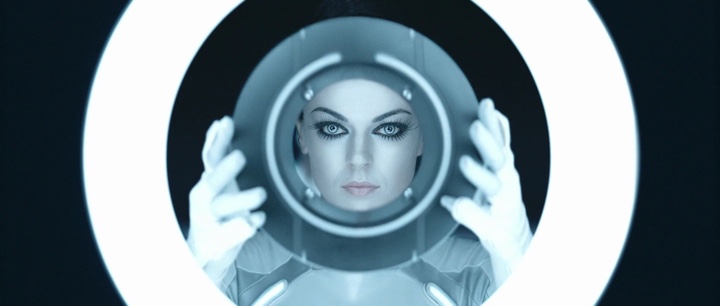
Kirill: The advances in the capabilities of visual effects make it possible to go beyond non-human characters and experiment in creating fully computer-generated human ones. For example, the CLU character in Tron is a younger “version” of Jeff Bridges. Do you think that a human face can be done realistically at the present moment or in the near future?
Rosalina: Maybe in the future. I think it’s still very questionable and not completely perfected. Of course everything changes, and every six months there’s a new way of doing things; it’s unbelievable how fast visual effects evolve. It’s the eyes, the mouth and the skin texture. I think the skin texture is hard to achieve, and it always looks so smooth and plastic while in reality it’s not quite like that. But whatever they do is amazing, we couldn’t even think about doing that years ago.
Kirill: And in the future where these capabilities are more realistic, how is your craft affected? Do you see make-up artists reduced to specifying the overall look, and the post-production stage applying that look?
Rosalina: I hope that never arrives. I hope the human touch is always there. I think there’ll be a place where you take the artists in the morning and you transform them visually in the computer, but it’s going to be incredibly expensive. In my humble opinion, there’ll always be place for the human touch and contact.
Kirill: It’s quite fascinating to see how the landscape of movie making is changing as compared to a few decades ago. Can you recommend a few movies that keep on inspiring you?
Rosalina: If you think about any of the old movies, like “Casablanca” or any of Fellini movies, don’t we reminisce about how wonderful they are? The contrast was quite amazing, with very blunt use of saturated colors. When I do my research for movies, I always watch Fellini to get inspiration. “Sweet Charity” with Shirley MacLaine is the first movie he did in US and I just love the incredibly beautiful visuals. I like to watch the old French “Casino Royale” with Ursula Andress and David Niven, it’s visually stunning. “Juliet of the Spirits” was the first movie were Fellini used color and “8½” are some of my favorites. “La Dolce Vita” of course. How can you not watch “La Dolce Vita” with Marcello Mastroianni. And “Fellini’s Roma” is another great one.

You can find Rosalina Da Silva on her blog A More Beautiful Makeup, on Facebook and on Twitter.
![]()
![]()
![]()
![]()
![]()
![]()
![]()
![]()
![]()
![]()